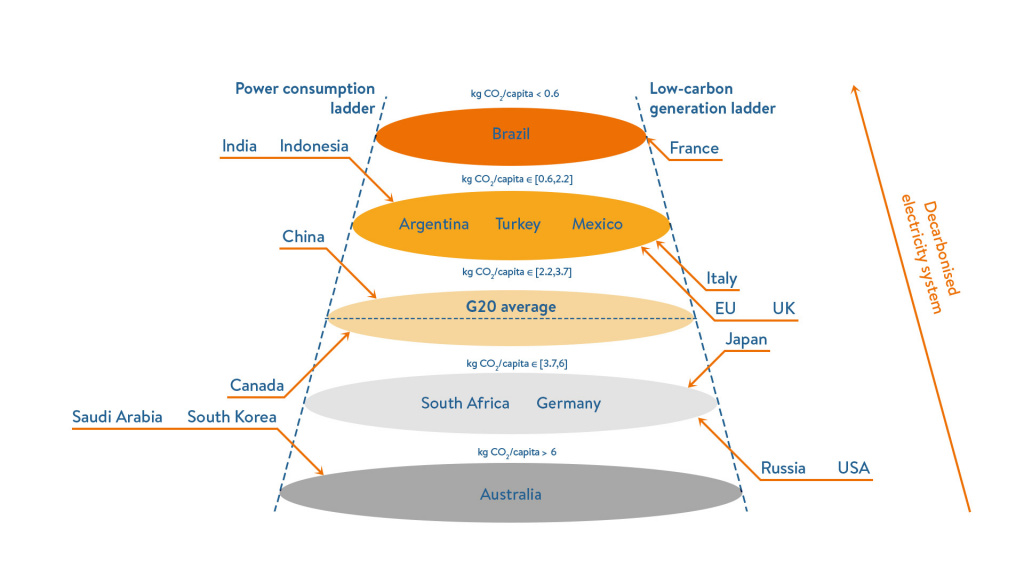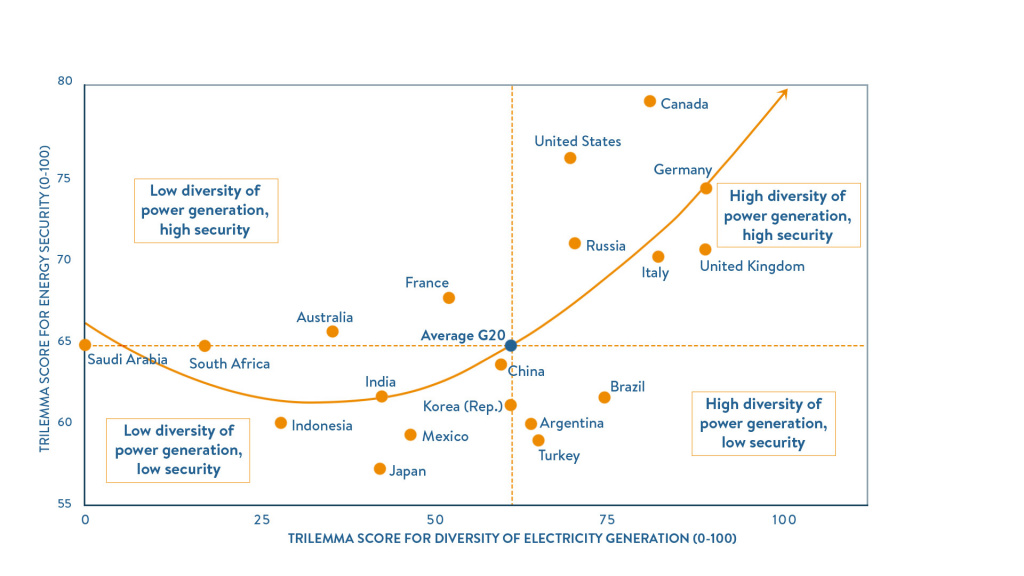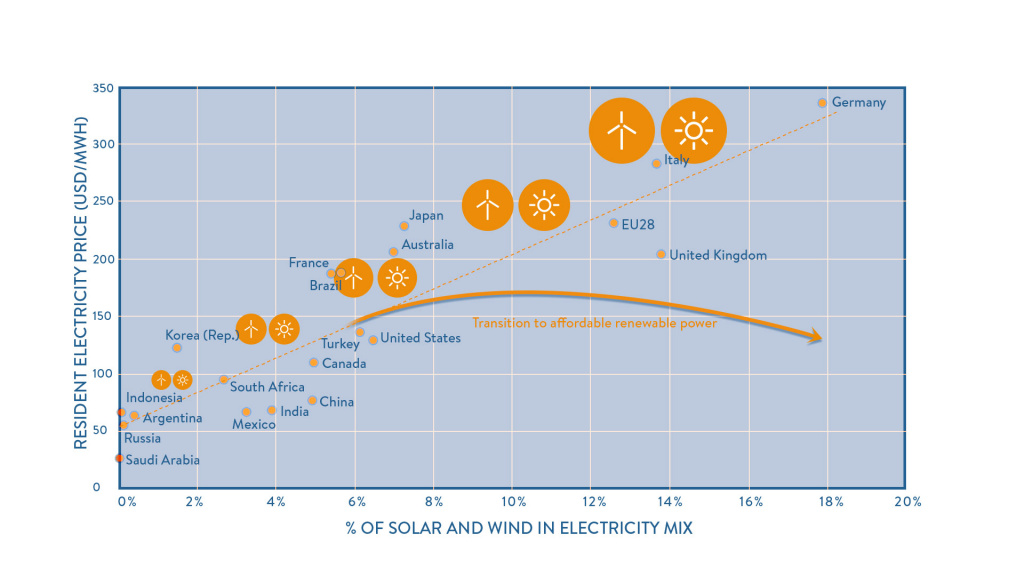Energy transition is a connected policy challenge. Success involves managing energy security, equity and environmental sustainability throughout the transition process. The Council’s Energy Trilemma Index, developed with the support of Oliver Wyman, provides an objective rating of national energy policy and performance across these three dimensions.
The 2018 World Energy Trilemma Index compared 125 countries around the world, using a broad set of key energy indicators. As G20 leaders meet in Osaka this week and in anticipation to the all-new Trilemma that will be revealed in September's upcoming 24th World Energy Congress, we take a closer look at their national ‘Trilemma triangles’ and the associated policy choices and transition pathway performance.
Tracking Trilemma performance over time shows that G20 countries follow two clear, but not mutually exclusive, routes to lowering emissions: decarbonisation of the electricity supply and reducing electricity demand.

(G20 CO2 emissions per capita. Some countries have not changed their emissions significantly, others have shifted between bands over the period 2006-2016. Click to see a full-resolution version)
-
European countries have made sustained efforts to decarbonise electricity production and manage demand, with the UK, Italy and France ahead with strong sustainability performance.
-
Power demand is growing rapidly in India, Indonesia and especially China. While their power mix is decarbonising, it is happening at a slower pace.The rapid evolution is stark: in 2004, electricity-derived CO2 emissions per inhabitant were twice as high in the UK than in China, whereas in 2016 they were twice higher in China than in the UK.
-
Australia, Saudi Arabia, the US, Korea and Russia have the most carbon intensive power systems in the G20, due to a high share of fossil fuels in their electricity mix coupled with high power consumption levels when compared to other G20 countries.
Trilemma analysis reveals that the most secure energy systems do not necessarily require significant reserves or net exports. Top performing countries have developed a diverse energy mix and a number of strong global relationships for long term supply.
A clear pathway to increased security is to diversify sources of electricity generation. Multiple and diverse sources of electricity enable a stable power system that is resilient to shocks in fuel prices or weather impacts. Higher security performers in the G20 are those countries with high diversity of electricity generation.

(Trilemma scores for Energy Security and diversity of electricity generation (2018).Click to see a full-resolution version)
-
Canada, the United States, Germany, Russia, the United Kingdom, and Italy have the highest Trilemma scores for diversity of power generation and these translate to the highest security scores.
-
Energy exporters like Saudi Arabia, South Africa, Australia and Indonesia, have the lowest Trilemma scores for diversity of power generation. While being net exporters is an asset for energy security, none of these countries have high security dimension scores.
Transitioning to renewable and lower carbon electricity generation while keeping electricity prices at affordable levels is a key challenge for G20 countries.

-
Solar and wind power have significantly developed in the European Union to reach a 13% share of the electricity mix in 2016, up from 3% in 2006. This has led to a 27% decrease in CO2 emissions from power generation in the EU between 2006 and 2016. However, feed-in tariff policies to help establish new technologies have contributed to rising electricity prices and growing concerns about the affordability of power and heat for households and industry. Several European countries have seen their Energy Equity indicators impacted by these trends.
-
The increasing penetration of renewables in Japan, Australia and Brazil could place these countries on a comparable pathway although there is hope that the scalable cost efficiencies of solar and wind power will not impact equity.
-
China, India, and Mexico have significant potential to develop their solar and wind resources so that generation capacity from these sources could become cost competitive with thermal sources. Solar and wind generation has increased threefold in Mexico between 2012 and 2016 with electricity prices remaining stable over the period.
G20 countries have strong industrial- and growing service- based economies, and shared goals for sustainable growth. Although they take different pathways towards energy transition, reflecting differing national contexts, all aim to make policy choices which represent ‘lowest overall cost, best fit to societies’.
The Trilemma Index provides G20 governments with a tool they can use to monitor individual progress, share learning and benchmark best practices. It offers a unique and practical platform to address new and common energy policy imperatives. Questions of comparison can be explored:
-
What does the comparison of leaders and laggards tell us about technological neutrality in leveraging existing technologies and innovation to achieve deeper and affordable decarbonisation?
-
What new policy choices (synergies, co-benefits, trade-offs) emerge in integrated policy pathfinding?
If you would like to learn more about the Council’s Trilemma Index, visit the latest tool and publication page via this link. The Council’s Transition Toolkit User Guide provides ideas for using the Trilemma, Scenarios, and other Council Tools to support transition impacts. Follow us on Twitter and LinkedIn to get the latest updates on the updated Trilemma that will be launched at the 24th World Energy Congress.





